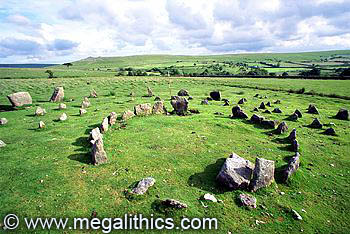
 |
Photo Gallery |
|
Panoramas |
||
Infrared |
||
| SX 57487 67846 (GPS 84min) | Diameter 19.3m (meas.) See text. |
| Visits - June 2000 | No magnetic anomalies |
The rings at Yellowmead were discovered in
1921 when covering heather was burnt off during a drought, the rings were
re-erected that autumn using local labour. This large scale reconstruction may
explain why the four nested rings are now non-concentric, or perhaps, the reason
may lie in the distant past, as it is probable that the outer rings were later
additions to an existing monument. The inner ring was probably filled by a
cairn, as the large, almost contiguous stones of this ring look very much like
the kerbs that would have encircled such a mound. The outer ring, and possibly
the inner, seemed to be graded to the SE arc.
Our measurements of the rings are, Outer ring 19.3m N-S 18.6m E-W 23 stones, 2nd
ring 15.1m N-S 13.7m E-W 25 stones, 3rd ring 11.8m N-S 11.1m E-W 30 stones,
Inner ring 6.15m dia. 21 stones. Some of the stones were very small and almost
totally buried, so the counts represent what was visible during our visit, all
of the stones seemed to be of grey granite.
We noticed a short double row of stones aligned ESE -WSW, this intercepted the
outer circle at the SW as it was not aimed at the centre of the rings. There
seemed to be a short extra arc of stones outside the outer ring, north of this
intercept.
Another find was a ring of five smallish stones 3m in diameter surrounding a
very cairn-like hump in the turf. This was 44m ENE of the rings, and may be on
the same line as the short stone avenue.
There are several other sites on Dartmoor where multiple rings are associated
with cairns and stone rows, some much more complex and extensive than what
survives at Yellowmead today.